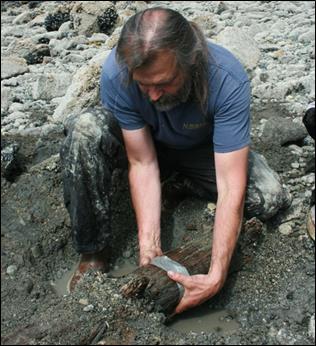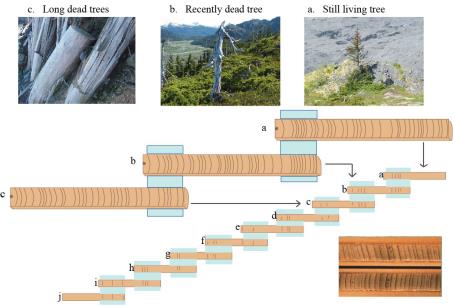What can interstadial wood tell us about the glacial history and paleoclimate of Glacier Bay?
Project Dates
Ongoing since 1989
Did You Know?
The oldest in situ (rooted in place) interstadial stump found in Glacier Bay is a 9,400 year-old specimen from upper Muir Inlet. The Sitka spruce had been growing for 200 years when it was buried in sediment deposited by advancing ice. Twigs found in Reid Inlet were dated to 13,770 years ago.
Introduction

“On my way back to camp I discovered a group of monumental stumps in a washed-out valley of the moraine and went ashore to observe them.” John Muir’s fascination with Glacier Bay’s ancient forests has been shared by many researchers since, especially Dan Lawson and his collaborators and students. For more than 20 years, this multidisciplinary study has been investigating the huge archive of information held in Glacier Bay’s remarkably-preserved interstadial wood and associated glacial deposits. The term “interstadial” means “between stages” and refers to decades– or centuries-long periods between glacial advances, when local conditions were temporarily conducive to forest growth.
Glacier Bay is the largest known repository in North America of interstadial wood from the Holocene period—the geological epoch that began at the end of the Pleistocene about 11,700 years ago and continues today. Delving into this storehouse of data, the researchers seek to reconstruct the paleoclimate and the highly complex sequence of glacial advance and retreat during the Holocene in the Glacier Bay region—not an easy task. The research involves linking the results obtained from several different methods of inquiry including radio-carbon dating of interstadial wood, analysis of the sedimentary deposits surrounding the wood, dendrochronology (tree-ring analysis), and integration of climate records with the dendrochronological and geological records.
The researchers hope to develop a 10,000-year tree-ring, calendar-dated glacial history and paleoclimate record for Glacier Bay and create models of ice-covered and ice-free areas that will permit reconstruction of park ecosystems in the past.
Methods and Findings

The researchers have spent countless hours tramping around the backcountry, in virtually all parts of Glacier Bay proper, searching for interstadial wood, particularly in situ stumps. They collect samples and analyze the glacial stratigraphy associated with the wood to determine, among other things, whether the death of the tree was caused by glacial advance. Each site is located by GPS and photographed. Various parameters, such as dimensions, position, species, and overall condition, are recorded. Almost all the interstadial wood in Glacier Bay is Sitka spruce or western hemlock. Cores are also taken from living trees in refugia sites. These sites, which are located above Beartrack Cove and on Excursion Ridge, escaped glaciation .
Back at the Tree Ring Lab at The College of Wooster, where 547 Glacier Bay samples are housed, the wood sections are carefully dried and sanded; some are radio-carbon dated. Ring-widths are measured to the nearest .001 mm and cross-dated by computer (verified visually) to form calendar-dated and “floating” (not yet linked to a known historical date) chronologies. Calendar dates may be assigned by radio-carbon dating or by cross-dating with other chronologies. A 1,500-year-long “master” chronology from Prince William Sound correlates well with chronologies from Glacier Bay. Tree-ring records from living trees have been correlated with meteorological records from Sitka dating back to the 1830s.
Data suggest that at least six cycles of glacial advance and recession have occurred within the last 5,200 years in Glacier Bay. Probably none of these except the neoglacial (most recent) advanced all the way to the mouth of the bay. Advance and retreat in the west and east arms of the bay occurred asynchronously.
The researchers have made it a priority over the years to involve college and high school students in their field work. Thirteen undergraduate theses have been written about various aspects of Glacier Bay’s geologic history by these students since 2007.
Last updated: September 15, 2016
